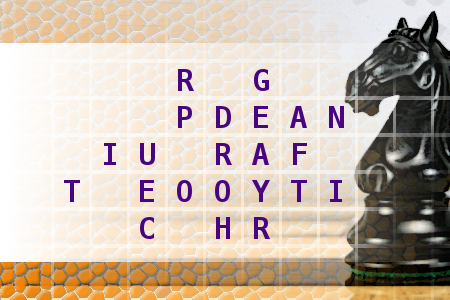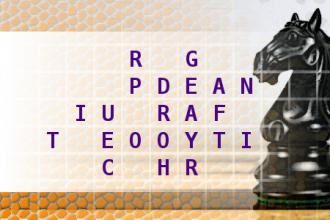Chess Knight Move
Find the title of novel, using the move of a chess knight. First letter is T. Length of words in solution: 3,7,2,6,4.Correct answers: 30
The first user who solved this task is Djordje Timotijevic.
#brainteasers #wordpuzzles #chessknightmove

A woman was at her hairdresser
A woman was at her hairdresser's getting her hair styled for a trip to Rome with her husband. She mentioned the trip to the hairdresser, who responded:
"Rome? Why would anyone want to go there? It's crowded and dirty. You're crazy to go to Rome. So, how are you getting there?"
"We're taking Continental," was the reply. "We got a great rate!"
"Continental?" exclaimed the hairdresser. "That's a terrible airline. Their planes are old, their flight attendants are ugly, and they're always late. So, where are you staying in Rome?"
"We'll be at this exclusive little place over on Rome's Tiber River called Teste."
"Don't go any further. I know that place. Everybody thinks it's gonna be something special and exclusive, but it's really a dump, the worst hotel in the city! The rooms are small, the service is surly, and they're overpriced. So, whatcha' doing when you get there?"
"We're going to go to see the Vatican and we hope to see the Pope."
"That's rich," laughed the hairdresser. "You and a million other people are trying to see him. He'll look the size of an ant. Boy, good luck on this lousy trip of yours. You're going to need it."
A month later, the woman again came in for a hairdo. The hairdresser asked her about her trip to Rome. "It was wonderful," explained the woman, "not only were we on time in one of Continental's brand new planes, but it was overbooked and they bumped us up to first class. The food and wine were wonderful, and I had a handsome 28-year-old steward who waited on me hand and foot. And the hotel was great! They'd just finished a $5 million remodeling job and now it's a jewel, the finest hotel in the city. They, too, were overbooked, so they apologized and gave us their owner's suite at no extra charge!"
"Well," muttered the hairdresser, "that's all well and good, but I know you didn't get to see the Pope."
"Actually, we were quite lucky, because as we toured the Vatican, a Swiss Guard tapped me on the shoulder, and explained that the Pope likes to meet some of the visitors, and if I'd be so kind as to step into his private room and wait, the Pope would personally greet me. Sure enough, five minutes later, the Pope walked through the door and shook my hand, I knelt down, and he spoke a few words to me."
"Oh, really! What did he say?"
"He said: 'Where did you get the shitty hairdo?'"
"Rome? Why would anyone want to go there? It's crowded and dirty. You're crazy to go to Rome. So, how are you getting there?"
"We're taking Continental," was the reply. "We got a great rate!"
"Continental?" exclaimed the hairdresser. "That's a terrible airline. Their planes are old, their flight attendants are ugly, and they're always late. So, where are you staying in Rome?"
"We'll be at this exclusive little place over on Rome's Tiber River called Teste."
"Don't go any further. I know that place. Everybody thinks it's gonna be something special and exclusive, but it's really a dump, the worst hotel in the city! The rooms are small, the service is surly, and they're overpriced. So, whatcha' doing when you get there?"
"We're going to go to see the Vatican and we hope to see the Pope."
"That's rich," laughed the hairdresser. "You and a million other people are trying to see him. He'll look the size of an ant. Boy, good luck on this lousy trip of yours. You're going to need it."
A month later, the woman again came in for a hairdo. The hairdresser asked her about her trip to Rome. "It was wonderful," explained the woman, "not only were we on time in one of Continental's brand new planes, but it was overbooked and they bumped us up to first class. The food and wine were wonderful, and I had a handsome 28-year-old steward who waited on me hand and foot. And the hotel was great! They'd just finished a $5 million remodeling job and now it's a jewel, the finest hotel in the city. They, too, were overbooked, so they apologized and gave us their owner's suite at no extra charge!"
"Well," muttered the hairdresser, "that's all well and good, but I know you didn't get to see the Pope."
"Actually, we were quite lucky, because as we toured the Vatican, a Swiss Guard tapped me on the shoulder, and explained that the Pope likes to meet some of the visitors, and if I'd be so kind as to step into his private room and wait, the Pope would personally greet me. Sure enough, five minutes later, the Pope walked through the door and shook my hand, I knelt down, and he spoke a few words to me."
"Oh, really! What did he say?"
"He said: 'Where did you get the shitty hairdo?'"

